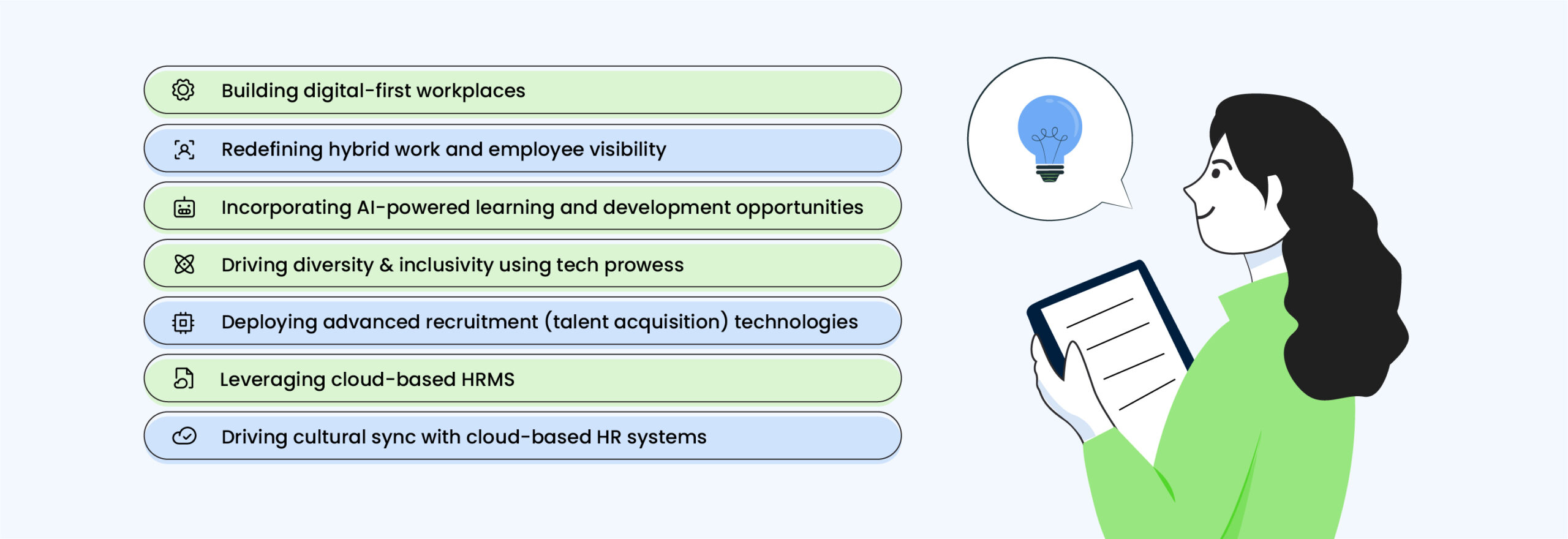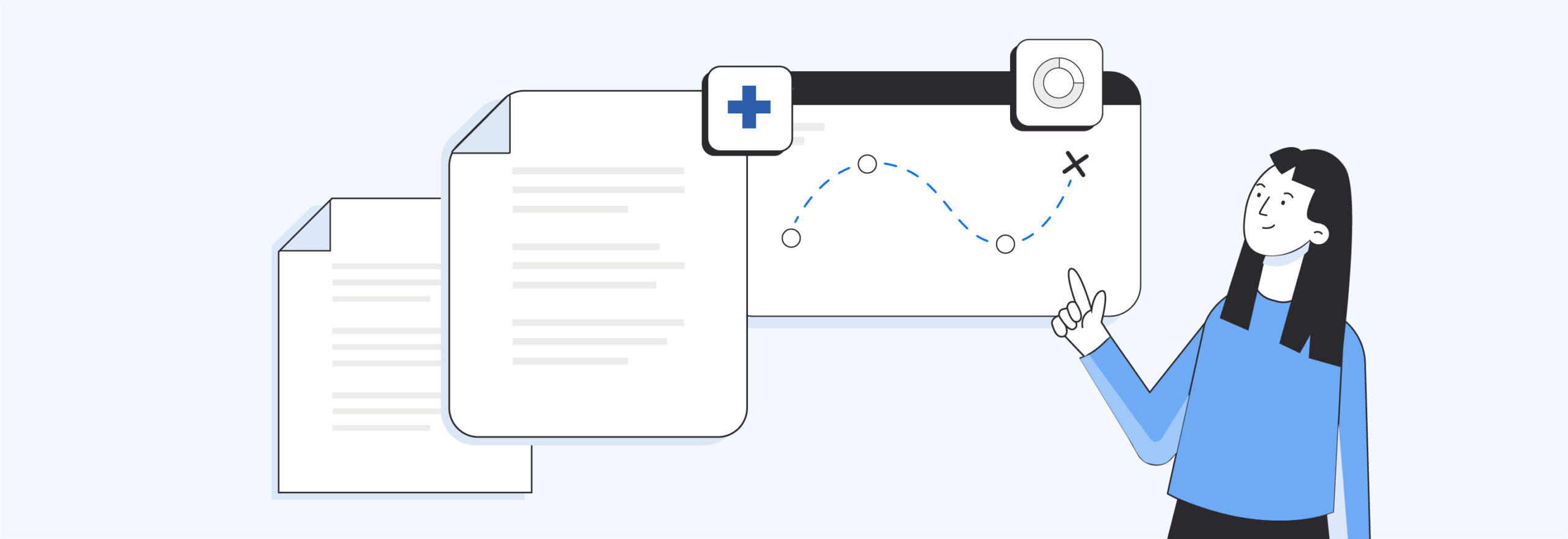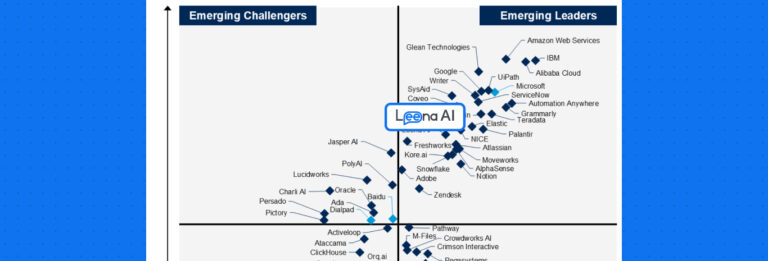Whether it is HR digital transformation, meeting employee expectations, or changing how people work and communicate, HR technology has helped establish a balance between people, processes, and technology during and after the pandemic.
Now, as we head into 2024, organizations have started looking at more effective ways to leverage technology that puts employees first – in their accessibility, ease of use, and direct relevance to making their professional and personal lives smoother.
Based on that, here are the top 7 HR technology trends for 2024 that can help you effectively streamline your people processes cost-effectively.
HR Technology Trends for 2024

Research suggests that the global HR technology market is projected to be at USD 39.90 billion in 2029, at a CAGR of 7.5% between 2022 and 2029. The adoption of HR technology is growing as more and more companies recognize the importance and benefits of delivering superior employee experiences.
Read on to find out the HR technology trends for 2024:
1. Building digital-first workplaces
Since March 2020, workplaces and interactions have dramatically shifted toward digitalization. Both companies and employees have transitioned to digital ways of collaboration and communication. Digitalization has replaced traditional, manual, and paper-based systems with automated digital systems. This slow but steady transition has already proven to improve efficiency, increase productivity, and reduce costs in the workplace.
Examples of digitalization at the workplace include leveraging cloud computing, digital document management, software-as-a-service applications, and mobile applications for communication with employees and customers.
In the next 3 to 5 years, organizations will also massively restructure their technical infrastructure, with the incorporation of artificial intelligence and machine learning playing a significant role in it. As a result, organizations will successfully create more adaptive, engaged, and productive workplaces.
2. Redefining hybrid work and employee visibility
Hybrid workplace models will become a significant HR technology trend in 2024. With the rising employee demand for remote working, companies are increasingly looking for ways to bridge the gap between in-office and remote work environments.
Hybrid workplaces provide a flexible and effective way to do this. A hybrid workplace combines elements of both traditional and remote working models.
Some examples of hybrid workplace models include: allowing employees to work some days remotely while coming into the office on other days; offering flexible office hours; providing remote and in-office employees with the same access to resources and technology; creating digital workspaces that are accessible to both remote and in-office employees.
With the right technology and processes in place, hybrid workplaces can help improve employee engagement and productivity while reducing costs and increasing efficiency.
Here are five ways in which HR technology can help build dynamic hybrid workplaces:
- Improve communication: HR technology can facilitate better communication between employees and managers even when they are working remotely.
- Ensure flexibility: HR technology can provide more flexibility to employees by allowing them to work from anywhere and anytime while accessing the same resources.
- Increase productivity: HR technology can help increase employee productivity by providing tools such as time tracking, task management, and automated workflows.
- Enhance collaboration: HR technology can foster better collaboration between employees and managers by providing tools such as video conferencing, instant messaging, and team chat.
- Improve security: HR technology can help secure data and prevent unauthorized access to sensitive information, even when employees are working remotely.
- Hyper-personalize work experiences: Hyper-personalizing workplaces and work experiences will be a critical HR tech trend as businesses increasingly recognize the need to tailor their offerings to employees’ needs and preferences.
By leveraging data-driven insights, organizations can create highly customized work experiences that will, in turn, enhance productivity and job satisfaction.
For example, employers can provide employees with a personalized workspace tailored to their preferences, such as adjustable desks, ergonomic chairs, and adjustable lighting. Organizations can also use chatbots to offer employees on-demand personalized support for resolving queries.
3. Incorporating AI-powered learning and development opportunities
Leveraging artificial intelligence-driven systems will enable companies to provide employees access to personalized, engaging, and relevant learning and development programs in 2024.
Automated and digitalized learning and development (L&D) will ensure quick and accurate delivery of the most up-to-date and relevant content to employees, eliminating the need for manual content curation and distribution.
Additionally, digitalized L&D will provide a more personalized experience to employees by aligning with their specific needs and objectives. Finally, automated and digitalized L&D will be more cost-effective and efficient, saving companies time and money and improving the quality and reach of their L&D programs.
Examples of this tech deployment may include myriad avenues for L&D:
- Automated online training programs tailored to individual needs
- Real-time feedback and data analysis to measure employee performance and identify areas for improvement
- Virtual reality and augmented reality-based learning simulations for fostering a highly immersive learning experience
- Intelligent virtual assistants or mentors can guide employees through learning, providing personalized feedback and insights
4. Driving diversity & inclusivity using tech prowess
Driving diversity and inclusivity at workplaces with technology will be another crucial HR tech trend in 2024. Organizations will use technology extensively to create a more equitable work environment, provide better access to valuable resources, and allow for better collaboration between employees from different backgrounds.
Here are a few examples of how technology can drive diversity and inclusivity in workplaces:
- Automated recruitment and onboarding systems to ensure equitable hiring processes
- Artificial Intelligence (AI) software to detect and address unconscious bias
- Employee engagement tools to facilitate team building and communication
- Training and development platforms to ensure all employees have access to professional development resources
- Virtual reality (VR) tools to create immersive learning experiences
5. Deploying advanced recruitment (talent acquisition) technologies
According to an SHRM report, the average cost-per-hire was $4,129 in 2015. The survey also found that most companies spent more on recruiting than training and development.
Automation can help reduce recruitment costs by streamlining processes such as posting job ads, screening resumes, scheduling interviews, and sending automated messages. Automation can also reduce errors associated with manual entry.
HR technology trends in 2024 will involve the automation of recruitment processes and the use of artificial intelligence and machine learning to better match candidates to job openings.
Automation will also provide personalized and tailored recruitment experiences for employers and job seekers. This will help streamline the recruitment process and reduce costs by connecting job seekers with the jobs that are best suited for them more quickly and efficiently.
Here are some examples of HR tech trends that will emerge in the talent acquisition space:
- Automated applicant tracking systems
- Social media recruiting
- Automated background or reference checks
- Predictive analytics to determine the optimal CTC offers based on industry, current role, expected salary, etc.
- Automated bulk interview scheduling
- Video interviewing
6. Leveraging cloud-based HRMS
Cloud-based HRMS is the present and will be the future of HR tech in 2024 due to its ability to provide efficient and cost-effective solutions to HR challenges. The technology would allow HR departments to store, access, and update employee information in one secure and centralized location.
This would eliminate the need for multiple databases, making it easier to access and share data across teams. Using cloud-based HRMS would also automate other processes such as payroll, onboarding, and performance appraisals.
A cloud solution provider with a global presence will be a boon to companies having a multiple-geo presence. For example, a company with multiple offices in different countries could use a cloud-based HRMS system to manage employee data in one central platform. This would allow the company to easily access data from any location and ensure that all offices follow the same HR processes.
The cloud-based HRMS would also make sending updates and tracking progress across different offices easier.
7. Driving cultural sync with cloud-based HR systems
Cloud-based HR tools can help drive cultural sync in companies with offices spread across geographies by enabling employees to collaborate and share information, regardless of their physical location. Features like video conferencing, document sharing, and message boards will ensure employees stay updated on company culture and best practices.
This way, companies with global offices can ensure that everyone follows the same practices and stays aligned toward the same goals.
Here are some practical examples of how cloud-based HRMS will help HR departments gain an edge:
- Payroll processing: This will reduce the time and effort required to process payroll, making it easier to stay up-to-date with employee payments.
- Employee onboarding: This will streamline the onboarding process, from collecting documents to training new hires and maintaining a record of each step.
- Performance appraisals: Cloud-based HRMS will make it easier for HRs to track employee performance and provide feedback.
- Attendance tracking: HRs can access a centralized system for analyzing employee attendance and absences.
- Employee data management: This will make it easier to store and access employee data, such as date of joining, reporting manager, previous companies, etc. All of this would be accessible for company offices across the globe with just a click!
The bottom line

The emerging HR tech trends for 2024 indicate that traditional HR roles that have mainly involved administrative tasks are now evolving.
To meet the needs of the modern workforce, HR teams are now looking into areas like employee engagement and experience. This has increased the scope of work for HR teams, who now need to embrace technology to keep up with the changing times. This is where solutions like Leena AI help catapult HR departments into a new orbit of efficiency and impact.
Leena AI is an AI-powered virtual assistant that enables organizations to craft employee experiences that matter. With artificial intelligence at its core, the Leena AI platform automates all administrative tasks and processes to let HRs focus on engaging employees, improving attrition rates, and helping the organization stand out as the best employer.
Want to learn more? Book a free demo with our experts today!






